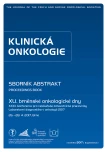Can we Observe Ethnic Difference in Basic Blood Tests? Single-institution Data from Cancer Prevention Programme in the Czech Republic
Authors:
M. Řiháček 1; D. Valík 1,2; R. Vyzula 3; L. Zdražilová Dubská 1,2
Authors‘ workplace:
Oddělení laboratorní medicíny, Masarykův onkologický ústav, Brno
1; RECAMO, Masarykův onkologický ústav, Brno
2; Klinika komplexní onkologické péče, Masarykův onkologický ústav, Brno
3
Published in:
Klin Onkol 2017; 30(Supplementum1): 170-173
Category:
Article
Overview
Background:
Laboratory tests are standard part of a routine check-up of current medical status and an important tool in diagnostic workup, in planning or evaluation of treatment, and disease monitoring. To reduce misdiagnosis, accurate reference intervals reflecting age, sex, ethnicity and other relevant clinical parameters must be established. We aimed to explore ethnic difference in basic blood parameters relevant for the Czech Republic.
Patients and Methods:
The study was performed analyzing blood tests from 13,126 individuals in cancer prevention program. Individuals were divided into two subgroups – 1. Czech, 2. Vietnamese, and laboratory parameters were compared.
Results:
Statistically significant differences were observed in majority of basic blood tests. These could be explained either by ethnical differences in basic biological parameters (weight, body mass) or dietary habits, such as in case of lower blood cholesterol levels and lower creatinine levels respectively in individuals of Vietnamese origin. Observed differences in erythrocyte-related parameters likely reflect higher incidence of haematogical disorders such as hemoglobinopathies.
Conclusion:
We observed statistically significant difference in basic blood tests between individuals of Czech and Vietnamese origin. Taking into consideration routinely used creatinine-based estimation of glomerular function, the most clinically relevant ethnic-based difference is substantially lower creatinine plasma level in individuals of Vietnamese origin.
Key words:
lab tests – reference range – ethnic specificity
The work was supported by Czech Ministry of Health via DRO 00209805 and by MEYS via NPS I (LO1413).
The authors declare they have no potential conflicts of interest concerning drugs, products, or services used in the study.
The Editorial Board declares that the manuscript met the ICMJE recommendation for biomedical papers.
Submitted:
13. 3. 2017
Accepted:
26. 3. 2017
Sources
1. Koerbin G, Sikaris KA, Jones GR et al. Evidence-based approach to harmonised reference intervals. Clin Chim Acta 2014; 432 : 99–107. doi: 10.1016/j.cca.2013.10.021.
2. Ozarda Y, Ichihara K, Barth JH et al. Protocol and standard operating procedures for common use in a worldwide multicenter study on reference values. Clin Chem Lab Med 2013; 51 (5): 1027–1040. doi: 10.1515/cclm-2013-0249.
3. Horio M, Yasuda Y, Imai E et al. Ethnic factors of the glomerular filtration rate estimating equation. Kidney Int 2012; 81 (8): 799. doi: 10.1038/ki.2011.489.
4. Teo BW, Xu H, Wang D et al. Estimating glomerular filtration rates by use of both cystatin C and standardized serum creatinine avoids ethnicity coefficients in Asian patients with chronic kidney disease. Clin Chem 2012; 58 (2): 450–457. doi: 10.1373/clinchem.2011.172346.
5. Blood pressure, cholesterol, and stroke in eastern Asia. Eastern Stroke and Coronary Heart Disease Collaborative Research Group. Lancet 1998; 352 (9143): 1801–1807.
6. Khor GL. Cardiovascular epidemiology in the Asia-Pacific region. Asia Pac J Clin Nutr 2001; 10 (2): 76–80.
7. Feuchtbaum L, Carter J, Dowray S et al. Birth prevalence of disorders detectable through newborn screening by race/ethnicity. Genet Med 2012; 14 (11): 937–945. doi: 10.1038/gim.2012.76.
8. Bain B, Seed M, Godsland I. Normal values for peripheral blood white cell counts in women of four different ethnic origins. J Clin Pathol 1984; 37 (2): 188–193.
9. Schoen I, Pizer M. Eosinophilia apparently related to cigarette smoking. N Engl J Med 1964; 270 : 1344–1347.
10. Bilano V, Gilmour S, Moffiet T et al. Global trends and projections for tobacco use, 1990–2025: an analysis of smoking indicators from the WHO Comprehensive Information Systems for Tobacco Control. Lancet 2015; 385 (9972): 966–976. doi: 10.1016/S0140-6736 (15) 602 64-1.
Labels
Paediatric clinical oncology Surgery Clinical oncologyArticle was published in
Clinical Oncology

2017 Issue Supplementum1
Most read in this issue
- Ascites May Provide Useful Information for Diagnosis of Ovarian Cancer
- Lactate Dehydrogenase – Old Tumour Marker in the Light of Current Knowledge and Preanalytic Conditions
- Molecular Pathology of Colorectal Cancer, Microsatellite Instability – the Detection, the Relationship to the Pathophysiology and Prognosis
- Circulating Myeloid Suppressor Cells and Their Role in Tumour Immunology
